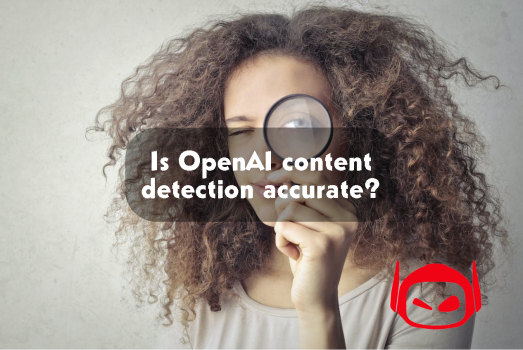Artificial Intelligence (AI) can drastically change the human world. In contrast to human intelligence, artificial intelligence is intellect displayed by machines. It was made to make everyone’s life simple and convenient. The quick adoption of OpenAI’s chat indicates that it has gained a significant position in peoples’ hearts. In a concise period, people worldwide grew accustomed to it.
Every new development has its pros as well as cons. Few people used the development of artificial intelligence, which was meant to improve human capabilities, as a cover for their flaws. OpenAI creators developed the content detector to address this issue. Yet, when compared to ChatGPT’s development and expansion, Content Detector fell short of expectations.
If you’re looking for a better alternative to ChatGPT, consider trying out Smodin. Smodin is an AI-powered chat tool that combines the power of Google and AI to give you the most credible and up-to-date information. With Smodin, you can chat with an AI that can help you with any query you have, from simple to complex questions. It’s easy to use, and you can get started with it right away. So, what are you waiting for? Give Smodin a try today!
The OpenAI Content Detector has several drawbacks. Let’s discuss a couple of issues that are manifesting larger issues.
OpenAI’s AI detector has proven itself incapable of identifying all AI-written texts accurately. As the best classifiers, it would have easily recognized the apparent characteristics of AI-written content. Researchers tested OpenAI’s AI detector and found it identified only 26% of AI-generated material. Moreover, 9% of the time, human-authored texts were mistakenly identified as having likely been created by AI tools.
The OpenAI’s detector offers a somewhat ambiguous response when determining whether AI produced a certain text. Based on its degree of confidence, it will identify the text as “extremely improbable” (less than 10% chance), “unlikely” (between 10% and 45% chance), “unclear whether it is” (45% to 90% chance), “possible” (90-98% chance), or “likely” (above 98% probability) AI-generated.
Apart from improper detection of AI-generated material, the language problem also arises. The research and the applicability of OpenAI’s Content Detector have given a negative result in the case of other languages except for English.
When it comes to shorter texts, the OpenAI content detector is inaccurate. The legitimacy of material with fewer than 1000 characters cannot be detected. Its greatest flaw is that, despite having characters over 1000, it still cannot accurately determine if a text was authored by a person or created by artificial intelligence.
The approach on which OpenAI’s Content Detector is built is now incorrect and will continue to be so if it is not corrected. It is a language model that has been adjusted using a dataset of comparisons between texts authored by humans and artificial intelligence on the same subject.
OpenAI’s Content Detector can be useful for identifying text that AI might have produced, but it shouldn’t be regarded as the sole indicator for concluding. The only explanation is the possibility of editing and manipulating AI-generated information.
Let’s quickly brush up on the major drawbacks of OpenAI’s Content Detector:
●It cannot distinguish between writing produced by AI and text authored by a person.
●A minimum of 1000 characters are needed to complete the task.
●Only operates effectively when performed in English.
●It cannot be trusted or used on a bigger scale project without inspection.
●It is based on a collection of manually and artificially written text on the same subject.
After having a detailed study of the various shortcomings of OpenAI’s Content Detector, we come to the real question, i.e. what is the solution to the current situation?
Well, the answer is Smodin. Smodin’s AI content detector is a cutting-edge technology that effectively distinguishes between text produced by ChatGPT, Bard, or other AI technologies and human-generated content. It is a multilingual AI content detector that is both free and incredibly accurate. The two categories of AI tolerance—lenient and strict—are presented to the audience. The expectation of accuracy is very high in both AI tolerances. Even professional authors, students, and educators rely on Smodin to authenticate their work and check it for digital alteration.
Anyone can easily operate Smodin by uploading the text. And in a few seconds of analysis, the efficient capability of Smodin’s AI checker will provide the individual with the uniqueness of the uploaded text. With the help of algorithms, it even suggests the required alteration and modification to the text.
Another key tool that Smodin offers is the AI Detection Remover. With this tool, you can bypass any AI detector effortlessly. It also humanizes content to make it sound natural and authentic. Most importantly, while it enhances the text, it does not change the message you’re trying to convey.
For better understanding, let’s recall the beneficial impact of Smodin.
●Identifies the text as AI-generated or produced by Humans.
● Detects the inconsistency of tone and style of the text.
●Determines the level of complexity of the text.
●Detects the factual errors, which are common in AI-generated texts.
●Checks grammar and spelling for the output.
Smodin offers several advantages besides being an effective AI content detector, including checking for Plagiarism, Rewrite, Citation Machine, Summarizer, Smodin Author (AI Writer), and Smodin Omni.
If you’re interested in learning more about how content detection can benefit you and avoid the issues with OpenAI’s Content Detector, then you should definitely check out this post. Smodin’s blog. Smodin’s blog post discusses the problems with OpenAI’s Content Detector and offers solutions to overcome these challenges. It provides valuable insights on how to identify AI-generated texts accurately and detect the authenticity of the content. Additionally, it offers an alternative tool to OpenAI’s Content Detector. So, if you’re looking for a reliable and efficient way to detect AI-generated texts, click HERE to read and start benefiting from it today.
